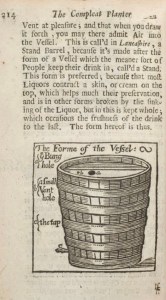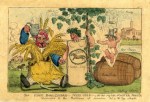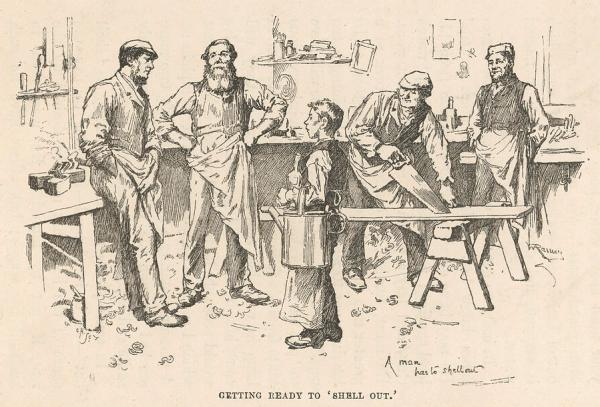
Part 1 includes the drinking of alcoholic beverages in the workshop and at the work site, the practice of footings and fees collected in the workshop and drinking after the workday ended.
Before water was clean and safe to drink the consumption of cider, ale and wine was a normal activity. Cider, cyder or sider was made from a variety of fruits each summer and autumn and ale was brewed in the home every few days. The day started with a ‘morning’ or ‘eye-opener’ and ended with a nightcap. Hard cider and ale were a significant source of daily calories and alcoholic mixtures were considered healthy. Alcohol consumption was also a normal part of working in the trades, both in the workshop and at work sites. The men of the trades became known for their drinking habits.
The Custom of the Shop

The artists responsible for painting the ceilings and crossbeams of Tereul Cathedral included the central figure offering liquid refreshment to the carpenters, with ready acceptance by the one on the right.
Peter Parler, the builder of St. Vitus Cathedral in Prague, was “awarded ad hoc sums for purchases, payments or bonus related to the building site. These amounts were related to…measuring cords, nails and metal sheets for templates…when 60 groschen were probably spent on a barrel of young beer distributed among the cathedral workers.”
In 1901, Stone – An Illustrated Magazine published an article “Rites and Ceremonies Connected with Building.” The last part of the article used contemporary diaries and accounts to describe the numerous alcoholic needs of the builders of the first stone building in Albany, New York, in 1656. A staircase was included in the plans: “A winding staircase was a feature of the fort, and when this was finished, five guilders’ worth of liquor gave the workmen the necessary winding gait to test it.”
You can read the account of the Albany stone building in the following link:
Building Rites and Drinking

The workday usually started close to dawn and breaks for breakfast and lunch were taken in the shop. Here’s an account from an article by Ivan Sparkes article about the chairmakers of High Wycombe, England:

Following the (some might say hard-drinking) traditions of immigrants from Europe, workmen in America also had plenty to drink. And as was traditional in Europe, the master was expected to provide the grog. When a ship-builder in Medford, Massachusetts decided not to provide the daily rum the men were not happy.
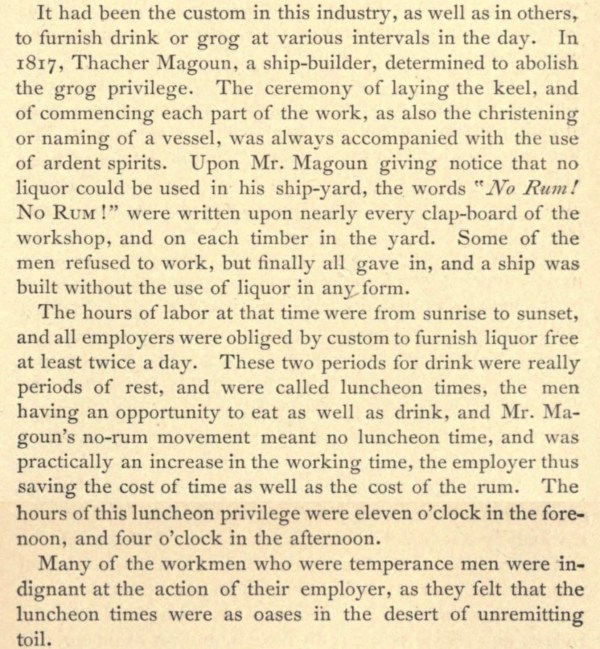
When Henry Hayes was bound into an apprenticeship in High Wycombe in 1824 among the many prohibitions was this term “He shall not…haunt taverns or playhouses.” Soon he would learn a tavern wasn’t needed in order to drink. Ten years later James Hopkinson was apprenticed at age 15 in Nottingham, and he very quickly learned the payments required to work in the shop: “…having cut out the wood for a table, I was told that I must pay a shilling for them to drink my health, and also that they expected my father to pay a sovereign towards a binding supper…and every fresh job that I had not made one like before, I had to pay a shilling or I should not have been allowed to make it.”
The footings, fees and fines that were required in a craftsmen’s workshop were extensive. In 1839 the 6th edition of John Dunlop’s “The Philosophy of Artificial and Compulsory Drinking Usage in Great Britain and Ireland” was published. Dunlop was the president of The General Temperance Union of Scotland and his book gathered information on drinking practices across society, for men, women and children, and in skilled and unskilled jobs. The summary for cabinetmakers and joiners in Scotland is as follows:

The summaries for the woodworking shops in England and Ireland are similar. Money for drinks was expected when a man was about to get married, when a child was born and in some cases when a workman wore a new shirt. It is important to remember Dunlop’s book has summaries of workshop practices and not every workshop surveyed had the same level of fees and fines for the purposes of drinking. There may also be a certain level of exaggeration on the part of workmen in an effort to shock a temperance worker. On the other hand, it is not surprising apprentices ran away and some men abandoned working in these shops altogether.
The Ivan Sparkes article also includes a passage on how disputes between two men or a disruptive man were handled.

Although drinking ale, beer, wine and “ardent” spirits was perfectly acceptable, being bowz’d, buskey or buzzey was frowned upon.
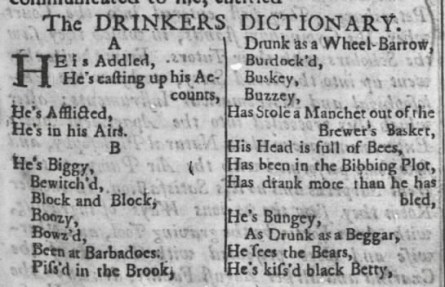 One of the founding fathers of America enjoyed his beer and wine, however, writing under the pseudonym Silence Dogood, he cautioned against overindulging and the loud and public drunk. Silence, otherwise known as Benjamin Franklin, gathered together all the terms used to describe the overindulged and in January 1737 published his “Drinker’s Dictionary” in the Pennsylvania Gazette. You can read the full dictionary here.
One of the founding fathers of America enjoyed his beer and wine, however, writing under the pseudonym Silence Dogood, he cautioned against overindulging and the loud and public drunk. Silence, otherwise known as Benjamin Franklin, gathered together all the terms used to describe the overindulged and in January 1737 published his “Drinker’s Dictionary” in the Pennsylvania Gazette. You can read the full dictionary here.
Being a known drunk could have consequences for a craftsman. In his article “Chairmaking in Low Cringles in Yorkshire” Christopher Gibert included this note from the account book of the Laycock family:

After Work and Possibly On the Way Home
Walking to a public house with only horses, carts and carriages in the way of traffic, was often the next step in the daily alcoholic intake of a craftsmen. (I have personally observed this except for the walking, horses, carts and carriages.) When it became unseemly for a woman to be seen in a public house, drinking establishments became an enclave for men.
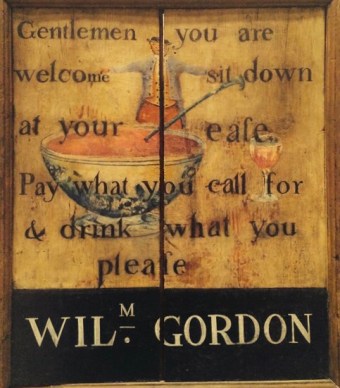
Craftsmen met to relax after work and before making their way home. Singing bawdy songs and songs about their favorite beverages was a popular pastime. Broadsides printed with the verses of ballads were pasted on the walls of public houses. Although we don’t know the melodies of all the old ballads we do have the verses. It is not too difficult to imagine that after a few beers a lively group of today’s woodworkers could come up with a tune to match the lyrics.
Because even drinkers want value for their hard-earned wages, one popular ballad from the around the middle of the 17th century was “Good Ale For My Money” and here’s a sample verse with the chorus:
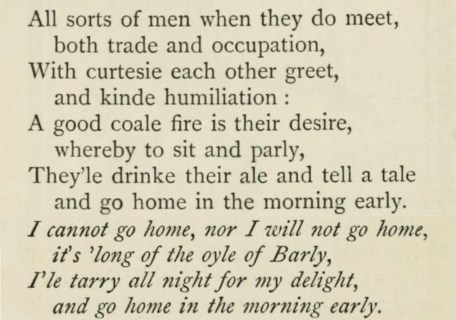
In one of the verses from “The Ballad-Makers Complaint” a woodcarver has a bit of a problem and comes up with a clever solution.
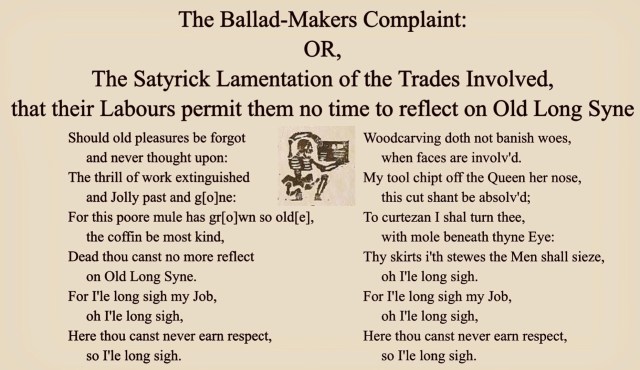
One song, that may trace its roots to pagan times is still familiar to us in the 21st-century. Steve Winwood and Traffic gave it new life in their version titled “John Barleycorn Must Die.” In the 17th century the song had various titles (and verses) and one of the more popular titles was:

John Barleycorn personifies the grain that can be made into beer or whisky. In a macabre manner the song describes the planting, harvesting and brewing of the barley. You can listen to a version of the song here.
Spending too much time in a public house could send a man and his family into poverty. Dipping back into John Dunlop’s book on “Drink Usage” he noted an additional practice detrimental to the wage earner. “Some masters and foremen keep a public-house, where they excite the men to take drink upon credit, and take it off the week’s wages: this is said to be “bringing sucken to their own mill.”
There is a similar passage in Ivan Sparkes’ article on High Wycombe, “Indeed one wife complained of the late payment of wages on Saturday evening, when the men would have to stand around and drink their future wages while waiting to be paid. She wrote to the local newspaper of the bad example set by her husband and his mates to their 12-year-old son, when they would come home tottering, have drunk a good part of their pay packet.”
The drinking song “The Jovial Cutlers” from the late 18th century includes a passage in the voice of a grieved wife who ultimately resorts to the Lysistrata stategy:
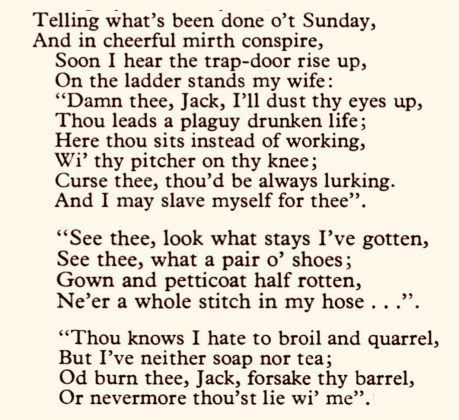
The public house was also where the early Mechanics’ Societies were formed and they paid their ‘rent’ in drinks bought from the owner. In 1790 a law was passed in England that prohibited payment of wages in liquor. It would be well into the 19th century before there was a law prohibiting the practice of requiring workers to collect their pay in public houses.
If you would like to read more about hazing, bullying, coercion, underage drinking, beatings, shunning (sent to Coventry) and extortion in workshops you can find John Dunlop’s book on “Drinks Usage” here.
The University of California at Santa Barbara has a database on English Broadsheet Ballads. You can read the text, or sing! along to “Have You any Work for a Cooper? OR a Comparison Betwixt a Coopers, and a Joyners Trade” from 1681 here.
Part 2 of The ‘Spirited’ Workshop will cover Saint Monday, a glimpse at how much alcohol was being consumed in the 19th century and a short discussion of temperance.
— Suzanne Ellison
